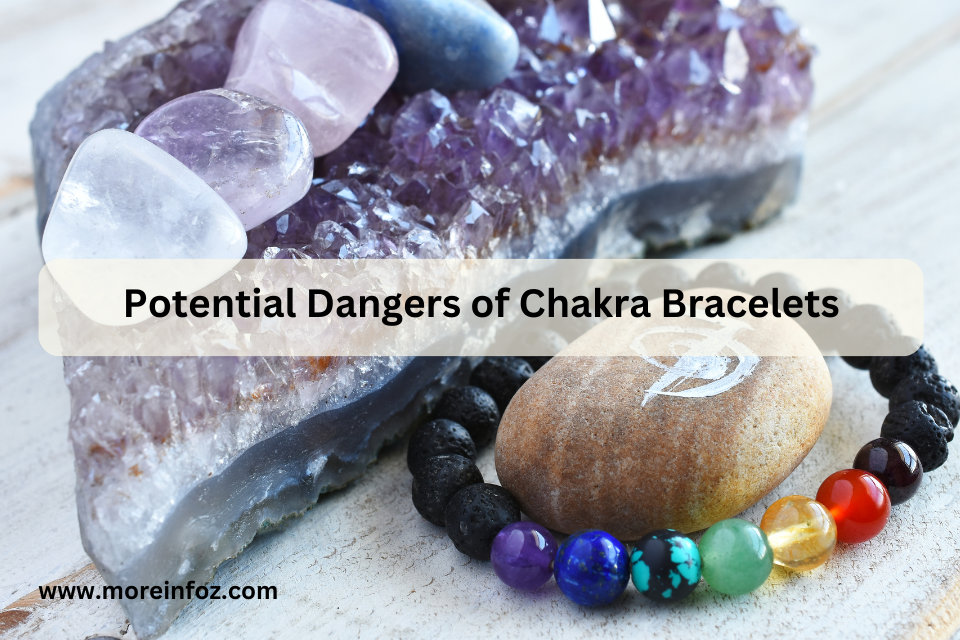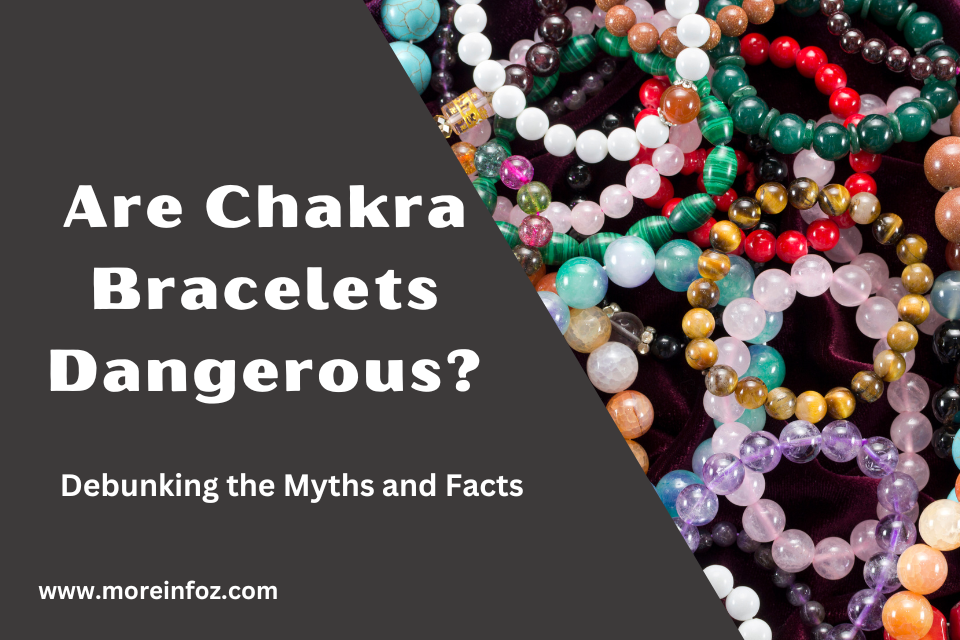Chakra bracelets have been a popular trend in recent years, with many people claiming that they can help balance the body’s energy and promote healing. However, there has been some controversy surrounding the safety of these bracelets. Some people believe that chakra bracelets can have negative effects on the body, while others argue that they are completely harmless.
So, are chakra bracelets dangerous? The answer is not straightforward. While there is no scientific evidence to suggest that chakra bracelets are harmful, some people may experience negative effects from wearing them. For example, some individuals may be allergic to the materials used in the bracelets, which can cause skin irritation or other allergic reactions. Additionally, some people may experience discomfort or pain if the bracelets are too tight or if they wear them for extended periods of time.
Understanding Chakra Bracelets
What Are Chakra Bracelets
Chakra bracelets are accessories that are believed to balance the energy centers in the body known as chakras. The chakras are said to be located along the spine and are responsible for our physical, emotional, and spiritual well-being. The idea behind chakra bracelets is that they contain gemstones or crystals that correspond to each of the chakras. When worn, the bracelet is said to help balance the energy flow in the body.
Components of Chakra Bracelets
Chakra bracelets are typically made up of seven different gemstones or crystals, each representing a different chakra. The following table lists the gemstones or crystals and their corresponding chakras:
| Gemstone/Crystal | Chakra |
|---|---|
| Amethyst | Crown |
| Lapis Lazuli | Third Eye |
| Blue Aventurine | Throat |
| Green Aventurine | Heart |
| Yellow Aventurine | Solar Plexus |
| Carnelian | Sacral |
| Red Jasper | Root |
In addition to the gemstones or crystals, chakra bracelets may also include other materials such as beads, charms, or pendants. The bracelet itself is usually made of elastic or string, allowing it to fit a variety of wrist sizes.
Overall, chakra bracelets are a popular accessory that many people believe can help balance their energy and improve their overall well-being. However, it is important to note that there is no scientific evidence to support these claims, and some people may experience negative effects from wearing chakra bracelets. It is always important to consult with a healthcare professional before using any alternative therapies.
Potential Dangers of Chakra Bracelets

Physical Risks
While chakra bracelets are generally safe to wear, there are some potential physical risks to consider. Firstly, if the bracelet is too tight, it may restrict blood flow and cause discomfort or even pain. It is important to ensure that the bracelet fits comfortably and does not cause any physical discomfort.
Secondly, some chakra bracelets are made with materials that may cause an allergic reaction in some individuals. For example, bracelets made of metal may cause skin irritation or allergic reactions in people with sensitive skin. If you have a history of skin allergies, it is important to check the materials used in the bracelet before purchasing it.
Psychological Risks
In addition to physical risks, there are also potential psychological risks associated with wearing chakra bracelets. Some people may become overly reliant on the bracelet and believe that it has a mystical power to heal or protect them. This can lead to a false sense of security and may prevent them from seeking appropriate medical treatment when necessary.
Moreover, some individuals may experience anxiety or stress if they believe that the bracelet is not working as intended. This can lead to a negative psychological impact and may exacerbate existing mental health conditions.
It is important to approach chakra bracelets with a balanced and rational perspective. While they may offer some benefits, they should not be viewed as a substitute for medical treatment or a cure-all for physical or psychological ailments.
Scientific Perspective on Chakra Bracelets
Chakra bracelets are believed to have healing properties and help balance the energy centers in the body. However, from a scientific perspective, there is no evidence to support these claims.
The concept of chakras is not recognized by modern medicine, and there is no scientific evidence to support the idea that wearing a chakra bracelet can have any physical or psychological benefits. In fact, there is no scientific evidence to suggest that chakras even exist.
While some proponents of chakra bracelets claim that they work by balancing the body’s energy fields, there is no scientific evidence to support this idea. The body does have electrical and magnetic fields, but these are not related to chakras or the concept of energy centers in the body.
Furthermore, some chakra bracelets are made with materials that can be harmful to the body. For example, some bracelets contain lead, which can be toxic if ingested or absorbed through the skin. Other bracelets are made with cheap materials that can cause skin irritation or allergic reactions.
In conclusion, from a scientific perspective, there is no evidence to support the claims that chakra bracelets have healing properties or can balance the body’s energy centers. Additionally, some chakra bracelets may even be harmful to the body.
How to Use Chakra Bracelets Safely
When using chakra bracelets, it is important to take certain precautions to ensure your safety. Here are some tips on how to use chakra bracelets safely:
- Choose high-quality bracelets: Always buy chakra bracelets from reputable sellers who use genuine stones and materials. Make sure the bracelets are well-made and durable.
- Cleanse your bracelet: Before using your chakra bracelet, cleanse it by placing it in sunlight or moonlight for a few hours. You can also use sage or other cleansing methods.
- Use the right wrist: It is recommended to wear chakra bracelets on your left wrist. This is because the left side of the body is considered the receiving side, and wearing the bracelet on this side allows the body to better absorb the bracelet’s energy.
- Don’t wear it all the time: While it may be tempting to wear your chakra bracelet all the time, it is important to take breaks from wearing it. This allows your body to adjust to the energy and prevents overstimulation.
- Listen to your body: Pay attention to how your body responds to wearing the bracelet. If you experience any discomfort or negative effects, remove the bracelet immediately.
By following these simple guidelines, you can safely enjoy the benefits of chakra bracelets. Remember to always use your intuition and listen to your body when using any type of energy healing tool.
Alternative Methods for Balancing Chakras
We understand that some people may be skeptical about using chakra bracelets to balance their chakras. Fortunately, there are alternative methods that can also be effective.
Meditation
Meditation is a powerful tool for balancing chakras. By focusing on each chakra and visualizing its energy flowing freely, you can help to unblock any energy that may be stuck. There are many guided meditations available online that can help you get started.
Yoga
Yoga is another great way to balance your chakras. Each yoga pose is designed to stimulate a specific chakra, helping to release any blockages. There are many different types of yoga, so it’s important to find one that resonates with you.
Crystals
Crystals have been used for centuries to balance chakras. Each crystal has its own unique energy that can help to unblock and balance specific chakras. Some popular crystals for chakra balancing include amethyst, citrine, and rose quartz.
Essential Oils
Essential oils can also be used to balance chakras. Each oil has its own unique properties that can help to unblock and balance specific chakras. Some popular oils for chakra balancing include lavender, frankincense, and peppermint.
Sound Therapy
Sound therapy is another effective way to balance chakras. Each chakra is associated with a specific sound frequency, and by listening to these frequencies, you can help to unblock and balance your chakras. There are many sound therapy apps and YouTube videos available that can help you get started.
Overall, there are many alternative methods for balancing chakras that can be just as effective as chakra bracelets. It’s important to find a method that resonates with you and to practice it regularly for the best results.
Conclusion
After reviewing the available evidence and considering the various perspectives on chakra bracelets, we believe that there is no clear evidence to suggest that these bracelets are inherently dangerous. However, as with any alternative health practice, it is important to approach chakra bracelets with caution and to be aware of potential risks.
One of the main concerns with chakra bracelets is the possibility of allergic reactions or skin irritation from the materials used in the bracelets. Some people may also experience discomfort or pain from wearing the bracelets, particularly if they are not used to wearing jewelry or if the bracelets are not properly sized or fitted.
Another potential risk associated with chakra bracelets is the possibility of relying too heavily on them for healing or spiritual growth. While these bracelets can be a useful tool for promoting mindfulness and meditation, they should not be seen as a substitute for professional medical or mental health care.
Overall, we believe that chakra bracelets can be a safe and effective way to support physical, emotional, and spiritual well-being, as long as they are used responsibly and in conjunction with other forms of self-care. As with any health practice, it is important to consult with a qualified health professional before incorporating chakra bracelets into your routine.
Frequently Asked Questions
What are the benefits of wearing a chakra bracelet?
Chakra bracelets are believed to have many benefits, such as promoting balance and harmony in the body’s energy centers. They can also help to reduce stress and anxiety, increase focus and concentration, and improve overall well-being.
How do you know if a chakra bracelet is genuine?
It can be difficult to determine if a chakra bracelet is genuine, as there are many different types and styles available. However, one way to ensure authenticity is to purchase from a reputable seller who specializes in chakra jewelry. Additionally, genuine chakra bracelets are typically made with natural stones and crystals, rather than synthetic materials.
What are the potential risks of wearing a chakra bracelet?
While chakra bracelets are generally considered safe, there are some potential risks to be aware of. For example, some people may experience skin irritation or allergic reactions to certain materials used in the bracelet. Additionally, wearing a chakra bracelet too tightly or for extended periods of time may cause discomfort or pain.
What is the recommended duration of wearing a chakra bracelet?
There is no set duration for wearing a chakra bracelet, as it can vary depending on the individual and their needs. Some people may choose to wear their bracelet all day, while others may only wear it during meditation or other spiritual practices. It is important to listen to your body and remove the bracelet if it becomes uncomfortable or causes any adverse effects.
Can wearing a chakra bracelet have negative effects on the body?
While chakra bracelets are generally safe, there is some concern that they may interfere with the body’s natural energy flow. Some experts suggest that wearing a chakra bracelet may cause an imbalance in the body’s energy centers, leading to negative effects on physical and emotional health. However, more research is needed to fully understand the potential risks and benefits of wearing a chakra bracelet.
Which wrist should you wear a chakra bracelet on?
There is no set rule for which wrist to wear a chakra bracelet on, as it can vary depending on personal preference and the specific energy center being targeted. Some people choose to wear their bracelet on the left wrist, as this is believed to be the receiving side of the body. Others may prefer to wear it on the right wrist, as this is believed to be the giving side. Ultimately, it is up to the individual to decide which wrist feels most comfortable and effective for them.





